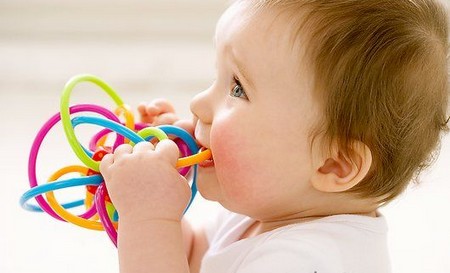Best Way to Help a Teething Baby or Toddler
Spotting your baby’s first tooth is an exciting moment. First teeth usually make an appearance between six and nine months, although some babies cut theirs as early as three months or as late as 12 months. Other babies are even born with a tooth already in place. Like lots of changes in your baby over the next few months, teething is affected by hereditary factors, and every child’s circumstances are unique.
Changes in behaviour
When your baby begins to teethe, don’t be surprised if you notice a change in her general behaviour. She may, for example, now refuse to drink from her beaker, having previously delighted in the independence it gave her, or insist on being held all the time when before she was quite happy to have periods sitting and playing by herself. Pain or discomfort from teeth can temporarily affect a baby’s pace of development and there may be some regression with previously acquired skills. Once she’s feeling like her old sell again, your baby will quickly pick up where she left off and continue to make progress.
How her teeth grow
Most babies first start to lose their gummy grins at about six months when the bottom front teeth, known as the lower central incisors (the cutting teeth), appear. The upper central incisors come next at between six and eight months, and the four lateral incisors break through at around nine months. Next come the four front molars (the flat grinding teeth) between 10 and 14 months, followed by the canines (the pointed eye teeth) and the front molars at between 16 and 18 months. Your baby’s back molars probably won’t appear until she’s nearing her second birthday. Most babies have all 20 milk teeth by the time they are two and a hall.
Is she teething?
Many babies show no obvious signs of teething, and you may be taken by surprise when her first tooth pops up through her gum. Other babies, however, are fretful and irritable, sometimes for a couple of months before a new tooth appears. It can be difficult knowing whether this unhappiness is being caused by something else such as illness (see below). But common signs of teething may include one, or all, of the following:
- swollen, reddened gums
- excessive drooling
- an inflamed check
- mild cough
- low-grade fever
- biting down on anything she can get in her mouth.
Teething and illness
Complaints such as those listed below are often blamed on teething, but should be treated as separate illnesses.
- High temperatures. A fever of 38″C or higher for more than 24 hours could be a sign of infection. Give your baby infant paracetamol, and if the fever continues for more than one day see your doctor
- Diarrhoea. This is serious since babies can become dehydrated very quickly. Give her plenty of fluids, and if it continues for more than 24 hours call your doctor
- Earache. If your baby is tugging at her ear, she may have an infection that could cause damage to her ear. It ran also become painful very quickly, call your doctor
- Chest infections. A mild cough is common when teething, since the excessive saliva produces extra mucus. If your baby has a temperature and has difficulty breathing, she may have a chest infection. Call your doctor
Caring for her teeth
As your baby’s teeth appear, start cleaning them twice a day with a child’s soft toothbrush and add a pea-sized blob of toothpaste when she’s able to spit out. If she won’t open her mouth for a toothbrush, use a clean finger. Encourage her to spit out, not swallow, the toothpaste. You should also avoid giving her sugary snacks, sweets, and drinks in between meals, and never give her sugared dummies, fruit juice, or honey drinks at bedtime.
Categories
Advertisements
Recent Articles
 How to Understand Bed Sizes – A Small Guide
How to Understand Bed Sizes – A Small Guide How to Select Some Must Have Kitchen Accessories
How to Select Some Must Have Kitchen Accessories Best Way to Change a Car Tire
Best Way to Change a Car Tire Best Way to Write an Affirmation
Best Way to Write an Affirmation Best Way to Take Charge of Your Financial Life
Best Way to Take Charge of Your Financial Life Best Way to Survive a Party When You Don’t Know Anyone
Best Way to Survive a Party When You Don’t Know Anyone Best Way to Stop Self Sabotaging Yourself
Best Way to Stop Self Sabotaging Yourself Best Way to Start Journal Writing
Best Way to Start Journal Writing Best Way to Speak with a Powerful Voice
Best Way to Speak with a Powerful Voice Best Way to Simplify Your Life
Best Way to Simplify Your Life Best Way to Respond to a Put-Down
Best Way to Respond to a Put-Down Best Way to Reduce Acne Breakouts
Best Way to Reduce Acne Breakouts Best Way to Recover from Dining Disasters
Best Way to Recover from Dining Disasters Best Way to Quit Your Job Gracefully
Best Way to Quit Your Job Gracefully Best Way to Make Your Own Website
Best Way to Make Your Own Website



Leave a Reply